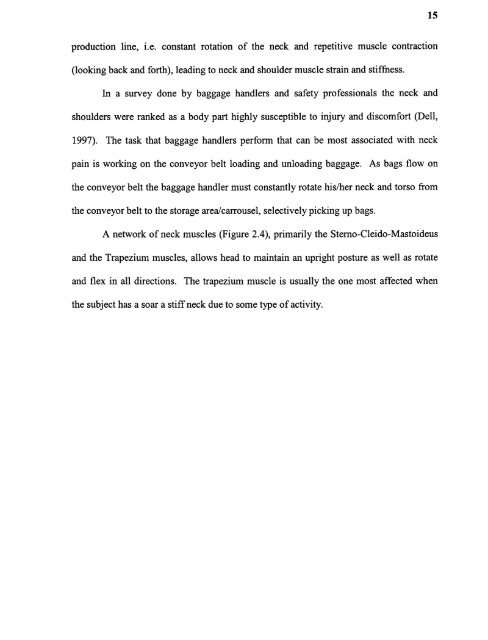An ergonomic assessment of the airline baggage handler
An ergonomic assessment of the airline baggage handler
An ergonomic assessment of the airline baggage handler
Create successful ePaper yourself
Turn your PDF publications into a flip-book with our unique Google optimized e-Paper software.
15production line, i.e. constant rotation <strong>of</strong> <strong>the</strong> neck and repetitive muscle contraction(looking back and forth), leading to neck and shoulder muscle strain and stiffness.In a survey done by <strong>baggage</strong> <strong>handler</strong>s and safety pr<strong>of</strong>essionals <strong>the</strong> neck andshoulders were ranked as a body part highly susceptible to injury and discomfort (Dell,1997). The task that <strong>baggage</strong> <strong>handler</strong>s perform that can be most associated with neckpain is working on <strong>the</strong> conveyor belt loading and unloading <strong>baggage</strong>. As bags flow on<strong>the</strong> conveyor belt <strong>the</strong> <strong>baggage</strong> <strong>handler</strong> must constantly rotate his/her neck and torso from<strong>the</strong> conveyor belt to <strong>the</strong> storage arealcarrousel, selectively picking up bags.A network <strong>of</strong> neck muscles (Figure 2.4), primarily <strong>the</strong> Sterno-Cleido-Mastoideusand <strong>the</strong> Trapezium muscles, allows head to maintain an upright posture as well as rotateand flex in all directions. The trapezium muscle is usually <strong>the</strong> one most affected when<strong>the</strong> subject has a soar a stiff neck due to some type <strong>of</strong> activity.
















